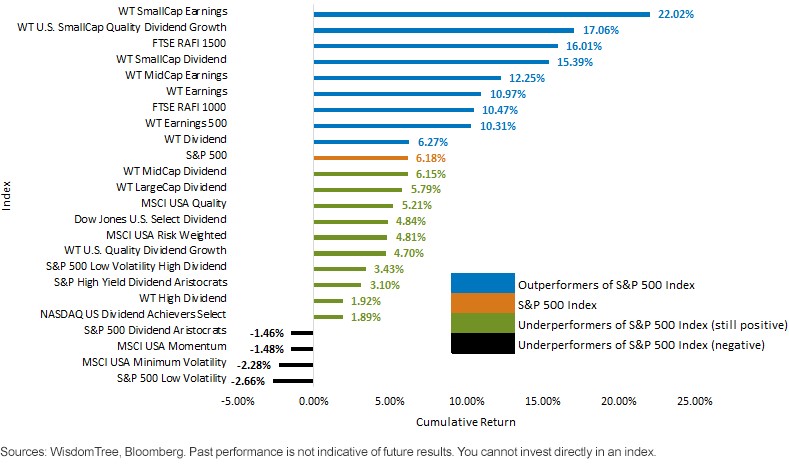
By Christopher Gannatti, Associate Director of Research, WisdomTree Investments
Special to the Financial Independence Hub
One of the biggest stories in 2016 was rising interest rates, most specifically that the U.S. 10-Year Treasury Note went from 1.36% on July 8 to 2.44% on December 31.1 While it may be too early to know if the greater than 30-year bull market in bonds (in other words, a longer than three-decade secular trend of falling rates) is over, 2016 did offer an interesting case study of smart beta strategies, many of which had only been in live calculation during falling rate periods.
How Strategies won as Rates rose
In the recent rising rate periods in 2013 (May 2, 2013, to December 31, 2013, when the U.S. 10-Year yield went from 1.62% to 3.03%)2 and 2016, a few big themes became clear:
- Small Caps: One aspect of small-cap companies is their ability to respond quickly to trends of improving growth, which is typically apparent during periods when the 10-Year yield is increasing. Additionally, they tend to have cyclical exposures regarding sectors instead of more defensive exposures. Also, if the U.S. dollar is strengthening (not unusual when the 10-Year yield is rising), these firms do not tend to have exports as their dominant source of revenue and therefore have less of a competitive headwind.
- Earnings: Rising rates tend to place strategies with higher valuations at risk, because one impact of rising rates is to lower the current valuation multiple of equities. WisdomTree’s earnings strategies are designed to provide lower price-to-earnings (P/E) ratio exposures to the market segments upon which they focus. It’s also notable that they tend to naturally be under-weight in the more defensive sectors of the market (Utilities and Telecommunication Services are two big examples) that usually tended to do better during the falling rate periods that directly preceded the rising rate period.
How Strategies Lost as Rates Rose
• Low Volatility/Minimum Volatility: It’s important to realize that the word “volatility” relates to both upside and downside market movements, seeking to lower both of them. Typically, this leads to very defensively oriented sector positioning, which can be problematic if the rising rate period is directly preceded by a significant fall in interest rates. Why? Well, this market movement can bid up the valuation of these more “falling rate”-oriented sectors. If the interest rate inflection point occurs quickly, these sectors may correct quickly, because they may have become among the most expensive in the market at that time.
• Momentum: Typical momentum strategies look at performance over distinct time horizons, tilting exposure to stocks that have performed positively over those horizons. The problem with an interest rate inflection such as the one that occurred in 2016 is that equity leadership can then change quickly, and it takes time for the momentum approach to rebalance and adjust to the change in conditions. In early 2016, there was also a big overlap between momentum indexes and low- volatility indexes in terms of constituents.
• Dividend Aristocrats/High Yield/High Dividend: As interest rates rise, bonds see their yields rise. At a certain point, bond yields begin to compete with equity dividend yields, and investors begin to prefer the lower potential volatility profile of bonds over equities. This is particularly pronounced if a period of low interest rates is extended in duration, because with a longer span of time, the need for income pushes more and more investors to seek alternative solutions outside of fixed income, thereby creating a larger pool to flock back to bonds when interest rates rise commensurately.
For standardized performance of WisdomTree Indexes, visit wisdomtree.com.
Understanding three groups within our chart:
- Outperformers of the S&P 500 Index: Because this is the most widely followed measure of U.S. equity performance on earth, it’s one question often asked even of strategies that don’t have a large-cap focus. In total, nine indexes shown here outperformed the S&P 500 Index over this period, and four were directly focused on small caps—not just any four, but the best-performing four. The WisdomTree SmallCap Earnings Index was the best, and it had the smallest-weighted average market capitalization along with a very cyclical sector positioning.
- Underperformers of the S&P 500 Index That Were Still Positive: Over this period, many dividend-focused strategies had positive returns but lagged the market with their tilt to more defensive and interest rate-sensitive sectors.
- Underperformers of the S&P 500 Index That Delivered Negative Returns: Four indexes wound up in this grouping, two of which focused on low-volatility strategies, one on high-dividend stocks, and one on momentum (which overlapped with minimum volatility from those stocks’ momentum in the first half of the year).
Smart beta indexes are gaining popularity. One of the constant refrains in due diligence is that one must know the factor exposures and how they perform in various market environments. The interest rate cycle in the last six months of the year provided a critical stress test for how various indexes have performed in different environments. If you view interest rates as potentially rising further in 2017, we believe it would definitely pay to study this period and the various moves in factor-oriented strategies.
1Sources: WisdomTree, Bloomberg.
2Sources: WisdomTree, Bloomberg.
Important Risks Related to this Article
Double-digit returns were achieved primarily during favorable market conditions. Investors should not expect that such favorable returns can be consistently achieved.
 Christopher Gannett is Associate Director of Research for WisdomTree Investments. he began at WisdomTree as a Research Analyst in December 2010, working directly with Jeremy Schwartz, CFA®, Director of Research. He is involved in creating and communicating WisdomTree’s thoughts on the markets, as well as analyzing existing strategies and developing new approaches. Christopher came to WisdomTree from Lord Abbett, where he worked for four and a half years as a Regional Consultant. He received his MBA in Quantitative Finance, Accounting, and Economics from NYU’s Stern School of Business in 2010, and he received his bachelor’s degree from Colgate University in Economics in 2006. Christopher is a holder of the Chartered Financial Analyst designation.
Christopher Gannett is Associate Director of Research for WisdomTree Investments. he began at WisdomTree as a Research Analyst in December 2010, working directly with Jeremy Schwartz, CFA®, Director of Research. He is involved in creating and communicating WisdomTree’s thoughts on the markets, as well as analyzing existing strategies and developing new approaches. Christopher came to WisdomTree from Lord Abbett, where he worked for four and a half years as a Regional Consultant. He received his MBA in Quantitative Finance, Accounting, and Economics from NYU’s Stern School of Business in 2010, and he received his bachelor’s degree from Colgate University in Economics in 2006. Christopher is a holder of the Chartered Financial Analyst designation.
Commissions, trailing commissions, management fees and expenses all may be associated with investing in WisdomTree ETFs. Please read the relevant prospectus before investing. WisdomTree ETFs are not guaranteed, their values change frequently and past performance may not be repeated. Past performance is not indicative of future results. This material contains the opinions of the author, which are subject to change, and should not to be considered or interpreted as a recommendation to participate in any particular trading strategy, or deemed to be an offer or sale of any investment product and it should not be relied on as such. There is no guarantee that any strategies discussed will work under all market conditions. This material represents an assessment of the market environment at a specific time and is not intended to be a forecast of future events or a guarantee of future results. This material should not be relied upon as research or investment advice regarding any security in particular. The user of this information assumes the entire risk of any use made of the information provided herein. Neither WisdomTree nor its affiliates provide tax or legal advice. Investors seeking tax or legal advice should consult their tax or legal advisor. Unless expressly stated otherwise the opinions, interpretations or findings expressed herein do not necessarily represent the views of WisdomTree or any of its affiliates. “WisdomTree” is a marketing name used by WisdomTree Investments, Inc. and its affiliates globally. WisdomTree Asset Management Canada, Inc., a wholly-owned subsidiary of WisdomTree Investments, Inc., is the manager and trustee of the WisdomTree ETFs listed for trading on the Toronto Stock Exchange.

